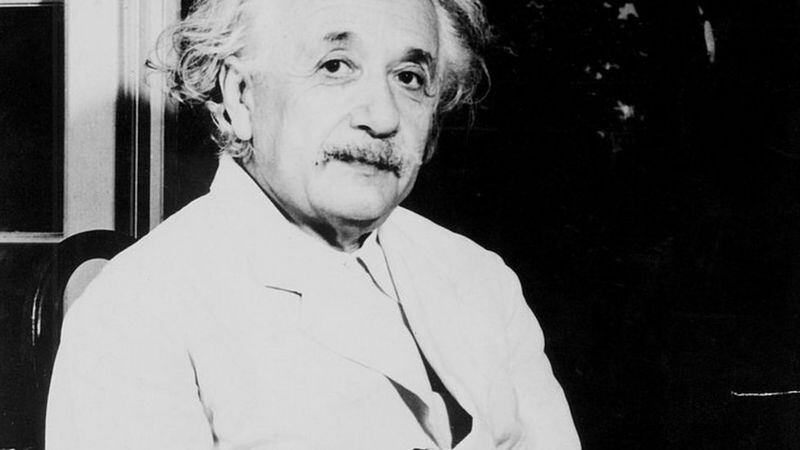Albert Einstein faced tremendously complex calculations to solve great riddles of the universe.
- Why German children receive a cardboard cone on their first day of school
- German Social Democracy elects new leadership and celebrates the rise of Scholz
- Germany speeds up coronavirus vaccinations with declining incidence
And, at the same time, it endured the fierce attack by Nazi scientists who, led by the envy, the anxiety to feel left behind before new theories and inspired by racist ideas, tried to stop the intellectual revolution that was brewing one of the most brilliant physicists of all time.
And they weren’t enemies small time.
For years, two Nobel laureates in physics, Philipp Lenard and Johannes Stark, led a campaign to discredit Einstein, based on a science influenced by the Nazi ideology.
His strategy was to impose a supposed “Aryan physics”, in contrast to what they considered a physicist that had been kidnapped by a, also supposed, “Jewish spirit”.
Lenard and Stark refused to acknowledge the two boldest theories of the time, both driven by Jews: Einstein’s relativity and Niels Bohr’s quantum mechanics.
Was such the pollutes Lenard and Star, that historians claim their efforts were comparable to wanting to become the “Führer of physics.”
How did Lenard and Stark hate Einstein arise, how was their persecution campaignAnd how far did they go in their endeavor to impose an “Aryan physics”?
An awkward genius
Einstein, of Jewish origin and increasingly recognized worldwide, was very uncomfortable for the Nazis.

In addition, your success it aroused jealousy Lenard, also a brilliant physicist, but without many of the attributes that made Einstein special.
Lenard received the Nobel Prize in Physics in 1905 for his study of cathode rays.
However, he had “limited intellectual depth and was emotional and imaginatively stunted”, As described by the scientific writer and former editor of the magazine Nature Philip Ball in his book Serving the Reich: The Struggle for the Soul of Physics under Hitler (“In the service of the Reich: the fight for the soul of physics under Hitler”).
Lenard was a largely experimental scientist and, according to Ball, his math skills were not enough for him. understand such daring ideas like relativity.

His inability to understand relativity led him to disqualify it as a theory, and the fact that it was supported by the international academic community made him think that it was a conspiracy.
Lenard clung to the idea that what we now know as space-time was the so-called ether, and he called relativity to be a “Jewish fraud”.
Stark’s case was similar.
In 1919 he had received the Nobel Prize in Physics for discovering that an electric field causes alterations in the spectrum of light, a phenomenon known today as Stark effect.
Stark was also an experimentalist who looked overwhelmed by mathematical complexity he was getting physics.

And like Lenard, he was also a extreme nationalist whose ideas had been radicalized after the First World War.
Such was his nationalism, that he came to clash with Nazi officers because, from his point of view, they were not the same. “Nazi enough.”
Both Lenard and Stark had joined the Nazis since before the party took over. can.
Racist science
Lenard was already criticizing relativity since 1910, but it was from 1920 that he began to add racist elements to their attacks, according to Ball.
His discourse was based on the fact that, while the Aryans clung to data and experimental work, the Jews were engrossed in abstract musings.
“Lenard’s argument was that any human endeavor, including science, was defined by race,” Alex Wellerstein, a science historian specializing in the history of eugenics, tells BBC World.
Lenard argued that different races had a different physics ”.

Since relativity and quantum mechanics include factors such as uncertainty and relativism, Lenard saw in these theories a threat to a well-organized society and a path to chaos.
In contrast, “Aryan physics,” which included experiments that had been on the rise in 19th-century Germany, emphasized tangible truths, in science that was applied to real problems and in an approach to reality strictly based on the experimental.
In general, Lenard and Stark’s arguments did not contain “Substantial criticism” a las ideas de Einstein, explica Wellerstein.
From a scientific point of view they were weak.
The most generous thing that could be said of the anti-Einstein arguments, says Wellerstein, is that at that time various aspects of his theories they had not finished completing, which opened the door for characters like Lenard or Stark to offer alternative explanations, ignoring the robust aspects of Einstein’s ideas.
Limited scope
In 1931, hundreds of philosophers and scientists participated in a publication against Einstein’s ideas.
Wellerstein, however, points out that “Aryan physics” really it was not very popular.
“I do not know of any exact number (of followers), but the accounts I have read make it seem that it was relatively small “says the expert.
“You have to keep in mind that the ideas that Lenard and Stark were promoting were not very interesting from the perspective of functional physics. It was physics from the past, not of the future ”.
What did Hitler think of all this?
The top Nazi leader was obviously aware of Einstein, world famous for his 1921 Nobel, and for being a dissident who refused to return to Germany after the rise of the Nazis.
Wellerstein, however, says he has not seen much evidence that Hitler considered Lenard and Stark’s campaign worthy of his. personal attention.
“Hitler did not need sophisticated reasons to to hate to the Jews and their creations ”, says the historian.
How was Einstein reacting?
In general, Einstein did not get involved a lot in the attacks of his detractors.
In 1920, however, he published a letter in response to one of the attacks on relativity orchestrated by Lenard.
“I admire Lenard as a teacher of the experimental physics”Einstein wrote.
“However, he has yet to achieve something in theoretical physics, and his objections to the theory of general relativity are so shallow, who had not considered it necessary, until now, to answer them in detail ”.
Según Wellerstein, Einstein walked away from public debates about his theories and let other physicists discuss them.
“To my knowledge, he did not try to influence the debates within Nazi Germany, perhaps aware that the only thing he would achieve would be shake them”, dice Wellerstein.
The failure of “Aryan physics”
Over time, the ideas of Lenard and Stark were losing force before the pragmatism Nazi officers.
In the midst of the war, these leaders were more interested in achieving results, developing weapons and technology, than in discussions about the interpretation of physics.
“The Nazis they never adopted ‘Aryan physics’ as part of their official ideology, ”says Wellerstein.
“’Aryan physics’ failed spectacularly, because even the Nazis had a hard time take it seriously, especially during the war ”.
Ball, for his part, explains that it was clear to the Nazis that the Jews who had proposed quantum theory and relativity were the ones who really knew the secrets of the atoms, and that only they were able to turn their findings into practical applications.
After the end of the war, came the Nuremberg trials in 1945.
By then Lenard was 82 years old and although he was briefly arrested and stripped of his title as Professor Emeritus at the University of Heidelberg, was never convicted and he died in 1947, as Ball explains in his book.
Stark too was saved of a severe sentence.
In 1947 he was sentenced to four years of work in the fields, but the sentence was suspended twice and died without fulfilling his codena in 1957, at the age of 83.
In 2020, the International Astronomical Union decided that two craters on the Moon that had been named Lenard and Stark in honor of these scientists, should cease to be named that way.
There are voices that go further and ask that they be withdrawn their respective Nobel Laureates.
In contrast, Einstein’s general relativity remains one of the most important theories of the modern physics, hoping someone will top her with really solid arguments.
RECOMMENDED VIDEO
IT MAY INTEREST YOU
- Germany approves mandatory vaccination for healthcare workers
- Man kills his wife and three children for a counterfeit coronavirus health pass
- High expectations for Olaf Scholz in Germany: What is expected of Angela Merkel’s successor?
- “Enter where the guy is, take him out and hang him”: Coronavirus deniers planned to assassinate German regional leader
- Who is Olaf Scholz, the new Chancellor of Germany with an “incredible resemblance” to Angela Merkel
.

:quality(75)/cloudfront-us-east-1.images.arcpublishing.com/elcomercio/N4LY63T6OZHKNEQKLJ5G6SBZFE.jpg)

:quality(75)/cloudfront-us-east-1.images.arcpublishing.com/elcomercio/BXNGSFRJVVCDJMP7XPYF6R56G4.jpg)

:quality(75)/cloudfront-us-east-1.images.arcpublishing.com/elcomercio/SUCZM4U7ZZHW3O7TA6FNRZMJEY.jpg)
:quality(75)/cloudfront-us-east-1.images.arcpublishing.com/elcomercio/ZE7XS7F7RNHJNALQH3NY55QE44.png)
